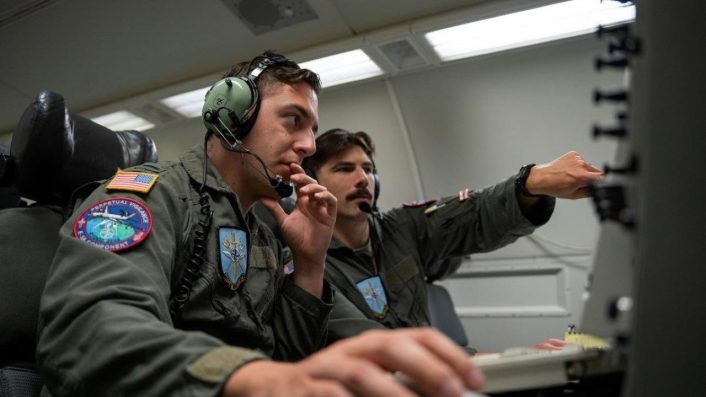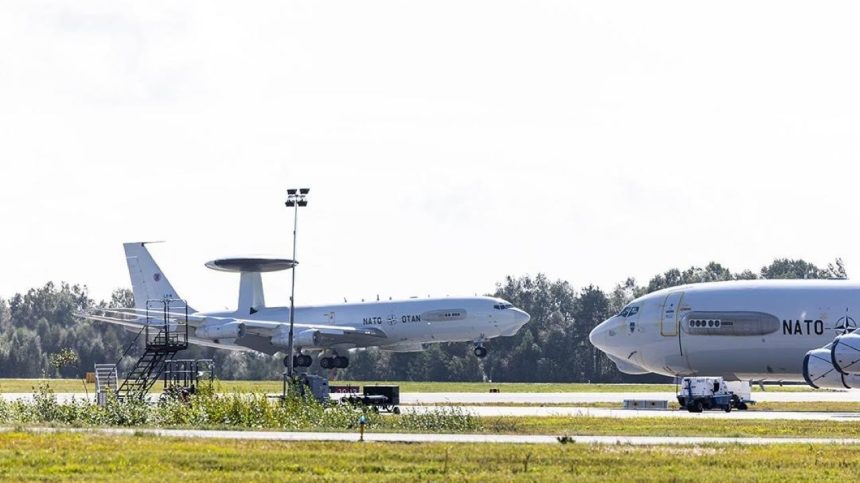For three weeks, NATO E-3A aircraft ‘flew surveillance and monitoring missions in an airspace north of Iceland as part of wider NATO joint vigilance operations’. Italian and French Airborne Early Warning aircraft joined the missions as national contributions providing continued surveillance support on a daily basis.
NATO’s three-week deployment of its E-3 Sentry AWACS (Airborne Warning Control System) aircraft to Norway’s Rygge air base, in the southern part of the country, concluded last week. The E-3 aircraft are assigned to the NATO air base at Geilenkirchen, Germany, which is home to the NAEW&C (NATO Airborne Early Warning and Control Force’s) component.
The alliance described this deployment, which the Norwegian military first announced on Aug. 22, 2024, as an “invaluable opportunity to provide” crews with “unique opportunities to test, evaluate and validate command and control capabilities.” The press release further added “it has proven to be an excellent opportunity to refine the AWACS readiness, as part of wider NATO joint vigilance operations.”
NATO and U.S. aircraft and drones like the E-3A, RC-135 Rivet Joint, MQ-4 Global Hawk and the MQ-9 Reaper provide 24-hour radar, electronic and optical surveillance to the Ukrainian military on Russian air force movements, air defense radars and ground positions.
At least two E-3 Sentry aircraft, callsigns NATO01 and NATO06, had been spotted on live flight-tracking websites in late-August, circling the length from northern Norway over the Norwegian Sea to northern Germany in two separate routes, operating from Rygge. On Sep. 16, one of them was flying from Rygge, this time with the callsign NATO40, over Denmark and then southwards to Germany.
Eye in the Sky✈️ #NATO‘s E-3A unit successfully completes deployment in 🇳🇴
Showcasing readiness, strength & interoperability with Allies 🇫🇷🇮🇹 & NATO’s capabilities to maintain information superiority in a complex environment
Read more: https://t.co/vDZ1IhPbkK pic.twitter.com/DtZ9tfwbZj
— NATO Air Command (@NATO_AIRCOM) September 16, 2024
Role and function of the deployment
The strategic role of the NATO E-3A is to “integrate airpower from across the Alliance and provide both surveillance and Command and Control functions that are imperative to defending” its airspace, says the press release. During the deployment, the E-3As “trained with naval assets and other air forces from various NATO nations, showcasing NATO’s readiness, strength and interoperability” with its Allies.
“With battle-proven AWACS capabilities, the NATO alliance is able to maintain information superiority in an increasingly complex environment,” further noted the Allied Air Command. For the three weeks, “NATO E-3A aircraft flew surveillance and monitoring missions in an airspace north of Iceland as part of wider NATO joint vigilance operations,” said a caption.
Italian and French Airborne Early Warning aircraft also joined the missions as national contributions, providing continued surveillance support on a daily basis. “NATO AWACS and participating national assets were key to mission accomplishment,” said Major General Gianluca Ercolani, Chief of Staff at Allied Air Command. “They also demonstrated interoperability and capability during combined operations in support of Alliance deterrence and defence,” he added.
“The strategic role of the NATO E-3A sits at the heart of NATO force projection. By operating out of Deployed Operating Bases, such as Rygge or elsewhere at short-notice, we showcase our determined ambition to maintain our vigilance and readiness to defend the Alliance”, said Air Commodore Andrew Turk, NATO Airborne Early Warning and Control Force Chief of Staff and Deputy Commander.

Airborne Early Warning’s importance in NATO
NATO E-3As last operated from Rygge during the Nordic Response exercise between February and March this year. During the time, NATO said that at Rygge, when the drills were underway, the participating countries operated two E-3A AWACS planes.
NATO is also in the process of replacing its fleet of 14 E-3A Sentry AWACS with six new E-7A Wedgetails, with the first one being expected to be delivered by 2031. The Royal Air Force also announced on Sep. 20 the completion of the first test flight of its own E-7A Wedgetail (UK serial number WT001), following the conversion at Birmingham International Airport.
The E-3A AWACS is referred to as NATO’s ultimate ‘Eye in the Sky’. As one of the few military assets both owned and operated by NATO, the AWACS mission is to perform all surveillance and battle-management tasks on behalf of the Supreme Allied Commander Europe.
Such deployments to integrate into joint missions demonstrate the “flexibility in being able to operate anywhere, anytime, to safeguard the Alliance,” says NATO. The aircraft can detect air and sea movements hundreds of kilometers away, sharing data with NATO commanders to provide them with a shared understanding of activities that take place in areas of particular concern.
ボーイングのロゴがちょうどいい位置に…!
2024.7.22 EGVA
E-3A Sentry (LX-N 90456)
NATO AWACS#エンジンは4つで細く長く騒がしく pic.twitter.com/9FYlATltH0
— エイブラムズ⊿³ (@IT_is_ABRAMS) August 27, 2024
In the press release, NATO defined its own role as a “defensive organization,” which “maintains transparency about the activities that are executed.” NATO AWACS has flown enhanced Vigilance Activities missions regularly along the borders of Allied Territory to secure NATO’s eastern flank. These missions have been part of NATO’s operations since 2014.









